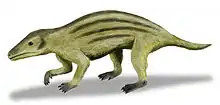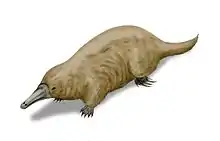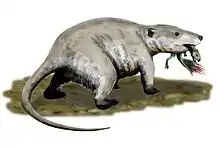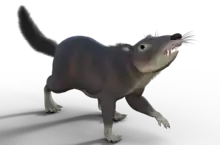Obdurodon
Obdurodon is a genus of extinct monotreme. They appeared much like their modern day relative the platypus, except adults retained their molar teeth. Unlike the platypus which forages on the lakebed, Obdurodon may have foraged in the water column or surface.[2]
| Obdurodon | |
|---|---|
 | |
| skull of Obdurodon dicksoni at American Museum of Natural History | |
| Scientific classification | |
| Kingdom: | Animalia |
| Phylum: | Chordata |
| Class: | Mammalia |
| Order: | Monotremata |
| Family: | Ornithorhynchidae |
| Genus: | †Obdurodon Woodburne & Tedford 1975[1] |
| Type species | |
| Obdurodon insignis | |
| Species | |
| |
Taxonomy
The genus was first described in 1975 by American palaeontologists Michael O. Woodburne and Richard H. Tedford based on two isolated teeth from the Lake Ngapakaldi to Lake Palankarinna Fossil Area in South Australia.[1]
The name derives from Latin obduros and don, "enduring tooth", a reference to the permanency of the molars.[1] The genus is one of several to have been placed with the family Ornithorhynchidae, whose only living member is the platypus.[3]
Obdurodon is represented by three species:
- Obdurodon insignis (type) Woodburne & Tedford, 1975[1]
- Obdurodon dicksoni Archer, et al, 1992[4]
- Obdurodon tharalkooschild Pian, et al, 2012[3]
Obdurodon insignis
| Obdurodon insignis Temporal range: Rupelian-Piacenzian | |
|---|---|
| Scientific classification | |
| Kingdom: | Animalia |
| Phylum: | Chordata |
| Class: | Mammalia |
| Order: | Monotremata |
| Family: | Ornithorhynchidae |
| Genus: | †Obdurodon |
| Species: | †O. insignis |
| Binomial name | |
| †Obdurodon insignis | |
Obdurodon insignis is an extinct species of ornithorhynchid monotreme discovered in the Tirari Desert in central Australia. The animal resembled the related modern platypus Ornithorhynchus but, unlike the platypus, had a bill that possessed molars as an adult.
Taxonomy
The holotype specimen, SAM P18087, a tooth, was uncovered in 1971 from the Lake Ngapakaldi to Lake Palankarinna Fossil Area in South Australia.[5] The second specimen discovered there, AMNH 97228, is an upper right molar.[1] In total, 4 specimens are known, dating from the Oligocene to the Pliocene.[6]
The tooth was placed into the newly erected genus Obduron when described in 1975 by American palaeontologists Michael O. Woodburne and Richard H. Tedford. The genus named was derived from Latin to describe the obdurate, that is persistent, molar which is lost in the modern platypus.[7] The species name insignis referred to the importance of the new taxon's "distinguishing mark" in the fossil record.[1]
Description
O. insignis is thought to have had a similar build to the modern platypus. However, like O. dicksoni but unlike the modern platypus, it had more permanent dentition.[8]
The holotype is the front molar of the upper right jaw, corresponding to the M2 molar, with the unusual character of six roots.[1] Fragments of jawbone have also been assigned to the species, along with a single piece of post-cranial material, a pelvis. Obdurodon insignis had one more canine tooth (NC1) than its ancestor Steropodon galmani.[1]
Obdurodon dicksoni
| Obdurodon dicksoni Temporal range: Miocene | |
|---|---|
| Scientific classification | |
| Kingdom: | Animalia |
| Phylum: | Chordata |
| Class: | Mammalia |
| Order: | Monotremata |
| Family: | Ornithorhynchidae |
| Genus: | †Obdurodon |
| Species: | †O. dicksoni |
| Binomial name | |
| †Obdurodon dicksoni | |
Obdurodon dicksoni is an extinct species of ornithorhynchid monotreme discovered in Australia. In life, it would have resembled a much larger version of its living relative, the platypus. The animal is known from Riversleigh fossils and is thought to have existed in the early to mid Miocene era, inhabiting pools and streams of freshwater in a rainforest environment. Unlike the modern species, the animal retained its molars into adulthood and had a spoon-shaped bill that suggest they fed near the surface or edge of the water.
Taxonomy
The species was published in 1992 by Michael Archer, F. A. Jenkins, S. J. Hand, P. Murray, and H. Godthelp, describing a skull and several teeth found in lower-middle Miocene deposits from the Australian Fossil Mammal Sites. The type specimen is an exceptionally well preserved skull, one of the most intact fossil skulls to be excavated from Riversleigh. The type locality is referred to as the Ringtail Site. Other than the skull and teeth, no other fossilised material of O. dicksoni has been identified.[9]
Description
A large platypus-like animal with a spoon-shaped bill that contained molars, unlike the modern species. The skull's profile is comparatively flatter than similar species, and as with crocodilians, this may indicate more foraging or feeding at the surface of the water. The diet is likely to have been crustacea, the water borne larvae of insects, or perhaps small vertebrates like fish and frogs. The only known area of its distribution, the Riversleigh site, was closed forest at the freshwater bodies it inhabited, surrounded by more open woodlands over the region's limestone karst terrain. [9]
The septomaxilla (a part of the upper jawbone) of O. dicksoni is bigger than for the platypus, which supposes a hypertrophied beak. The coronoid and angulary processes of O. dicksoni have quite disappeared in the platypus, leaving the platypus's skull flat on the sides. This indicates the mastication technique of O. dicksoni was different from that of the platypus, using the muscles anchored to these processes. O. dicksoni's beak has an oval hole surrounded by bones in the center, whereas the platypus' beak has a V-shape and no longer surrounded by bones. O. dicksoni retained molar teeth into adulthood, whereas in the modern platypus, the adults only have keratinized pads (juveniles lose their molar teeth upon adulthood). The shape of its beak suggests that O. dicksoni sought prey by digging in the sides of rivers, whereas the modern platypus digs in the bottom of the river. O. dicksoni had (like the platypus) shearing crests instead of incisor and canine teeth. It bore two premolars and three molars on each side of the lower jaw. The M1 had six roots, the M2 had five, and the M3 only one. The upper jaw bore two premolars and two molars on each side. The M1 had six roots, the M2 four. The premolars had only one root and a very different shape from the molars. They were separated from the shearing crests by an area without dentition. The roots of the molars were barely a third as high as the crown. Molars had only been found apart from skulls, implying that they were not well-anchored.[4]
An illustration of the species by Jeanette Muirhead, depicted on a rock in a stream within a rainforest, was published by the magazine Natural History (AMNH) in 1994.[5]
Obdurodon tharalkooschild
| Obdurodon tharalkooschild | |
|---|---|
| Scientific classification | |
| Kingdom: | Animalia |
| Phylum: | Chordata |
| Class: | Mammalia |
| Order: | Monotremata |
| Family: | Ornithorhynchidae |
| Genus: | †Obdurodon |
| Species: | †O. tharalkooschild |
| Binomial name | |
| †Obdurodon tharalkooschild Pian et al., 2013[3] | |
Obdurodon tharalkooschild is an extinct species of monotreme in the genus Obdurodon. It is known from a single tooth found at the Miocene-aged Two Tree Site fossil beds in Riversleigh in Queensland, Australia.[10][11]
Taxonomy
The type material, a single tooth, was discovered in 2012 by a team from the University of New South Wales including Mike Archer, Suzanne Hand, and Rebecca Pian.[12] The description, published in the same year, was the fourth species of the family Ornithorhynchidae to be described, the second from the Riversleigh site, and estimated to have been the largest.
The specific name was chosen in honour of an indigenous Australian creation story for the platypus, where a duck named Tharalkoo gives birth to a chimeric creature after being ravished by a rakali.[12]
Description
The living animal is assumed to be very similar in form to a modern platypus, but larger, exceeding Monotrematum in size and length.[12] The species was estimated to have been present in the middle and upper Miocene (5–15 million years ago). The wear patterns on the tooth are suggestive of crushing, perhaps by consuming hard-shelled animals such as turtles, rather than using a shearing action. Obdurodon tharalkooschild is thought to have inhabited fresh water and hunted for a variety of animal prey in the forests that dominated the Riversleigh site at the time of deposition. The species diet is assumed to have included crustacea like those consumed by the modern platypus, although larger species were available due to its greater size. The potential prey of the Riversleigh fauna also included frog, turtle, fish and the lungfish, species that are present in the deposition at the Two Tree Site of the Riversleigh formations.[12] The ornithorhynchid species were unknown in the later fossil record at the time of discovery, and it defied the assumptions of a single lineage of a platypus-like animal that progressively lost its teeth and became smaller in size.[12]
Cultural references
The name given to the species was discussed in a 1990 paper by Mike Archer, an Australian mammalogist, detailing a creation story with an Ugly Duckling motif in the context of palaeontology.[13][7] A philosophical examination of historical sciences such as palaeontology, published in 2018, uses the tooth of this platypus as an example of the results obtainable by multiple methods of research into traces of evidence; the author refers to the species by the vernacular "platyzilla".[14]
References
- Woodburne, Michael O.; Tedford, Richard H. (1975). "The first Tertiary monotreme from Australia". American Museum Novitates. 2588. hdl:2246/2005.
- Masakazu Asahara; Masahiro Koizumi; Thomas E. Macrini; Suzanne J. Hand; Michael Archer (2016). "Comparative cranial morphology in living and extinct platypuses: Feeding behavior, electroreception, and loss of teeth". Science Advances. 2 (10): e1601329. doi:10.1126/sciadv.1601329.
- Rebecca Pian, Michael Archer & Suzanne J. Hand (2013). "A new, giant platypus, Obdurodon tharalkooschild, sp. nov. (Monotremata, Ornithorhynchidae), from the Riversleigh World Heritage Area, Australia". Journal of Vertebrate Paleontology. 33 (6): 1255–1259. doi:10.1080/02724634.2013.782876.
- M. Archer, F. A. Jenkins, S. J. Hand, P. Murray, and H. Godthelp. 1992. Description of the skull and non-vestigial dentition of a Miocene platypus (Obdurodon dicksoni n. sp.) from Riversleigh, Australia, and the problem of monotreme origins. Platypus and Echidnas 15-27.
- Archer, M. (1994). "Mammals Eggstraordinaire". Natural History. American Museum of Natural History. 103 (Jan–Jun): 48–49 (illustrated).
- "Fossilworks: Obdurodon insignis". fossilworks.org. Retrieved 19 May 2019.
- Crowther, Mathew (November 5, 2013). "Fossil of giant platypus unearthed in Riversleigh". The Conversation.
- Musser, A.M.; Archer, M. (29 July 1998). "New information about the skull and dentary of the Miocene platypus Obdurodon dicksoni, and a discussion of ornithorhynchid relationships". Philosophical Transactions of the Royal Society of London. Series B: Biological Sciences. 353 (1372): 1063–1079. doi:10.1098/rstb.1998.0266. PMC 1692307. PMID 9720105.
- Musser, A. "Obdurodon dicksoni". The Australian Museum.
- Dell'Amore, Christine (November 4, 2013). "Giant Platypus Found, Shakes Up Evolutionary Tree". National Geographic.
- AFP (2013-11-05). "Extinct 'Godzilla' platypus found in Australia - Yahoo News UK". Retrieved 5 November 2013.
- "Giant extinct toothed platypus discovered". UNSW Newsroom. 5 November 2013.
- Archer, Michael (1990). "Tharalkoo's child: an ugly duckling story. -Aboriginal dreamtime legend, and palaeontology of the platypus". Australian Natural History. 23 (7): 574–575.
- Currie, Adrian (2018). "The Tooth of the Platypus". Rock, Bone, and Ruin: An Optimist's Guide to the Historical Sciences. MIT Press. pp. 1–30. ISBN 9780262037266.
Bibliography
- Archer, et al. "Description of the skull and non-vestigial dentition of a Miocene platypus (Obdurodon dicksoni) from Riversleigh, Australia, and the problem of monotreme origins".
- Augee, M.L. "Platypus and Echidnas". Royal Zoological Society of New South Wales. 1992. Pages 15–27. (O. dicksoni).
- Woodburne and Tedford. "The first Tertiary Monotreme from Australia." American Museum. Novitates Number 2588. 1975. Pages 1–11. (O. insignis).
External links
| Wikimedia Commons has media related to Obdurodon. |
| Wikispecies has information related to Obdurodon. |





